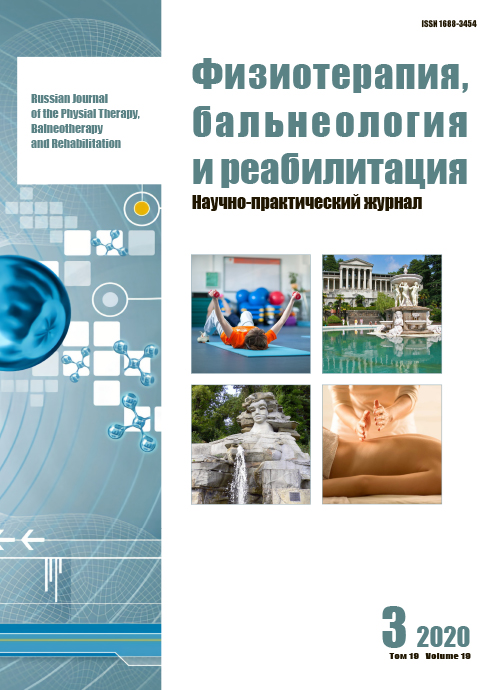A method of treating complications after contour plasty with preparations based on stabilized hyaluronic acid in the nasolacrimal sulcus region
- Authors: Aksenenko I.P.1, Gerasimenko M.Y.2
-
Affiliations:
- Clinic Esthetic Meditsiny
- Russian Medical Academy of Continuous Professional Education
- Issue: Vol 19, No 3 (2020)
- Pages: 145-151
- Section: Original studies
- Published: 15.09.2020
- URL: https://rjpbr.com/1681-3456/article/view/57999
- DOI: https://doi.org/10.17816/1681-3456-2020-19-3-2
- ID: 57999
Cite item
Abstract
Background. In order to correct involutive changes in the skin or aesthetic defects, fillers based on stabilized hyaluronic acid, which are used to fill in various wrinkles and creases, have recently become most popular. It is the procedure of contouring that is one of the three most popular cosmetic procedures.
Objective: to study the effectiveness of a combined method that includes a course of longidase diadinamophoresis and injectable carboxytherapy in correcting complications of contouring the nasolacrimal sulcus area with fillers based on stabilized hyaluronic acid.
Methods. There were 29 women under observation, average age 36.4 ± 4.4 years with complications after the introduction of a filler based on stabilized hyaluronic acid with localization in the nasolacrimal sulcus. There were 3 groups of patients who received a course of longidase diadinamophoresis (3000 IU), a course of carboxytherapy, or a combination of them.
Results. The use of a combined course of longidase diadinamophoresis (3000 IU) and carboxytherapy has a significant effect, reducing the clinical manifestations in the form of contouring and compaction, local edema and neuropathy, and stabilizing the psychoemotional state of patients. In addition, the treatment complex significantly accelerates the biodegradation of the filler and has a restructuring effect on the skin of the nasolacrimal furrow-reduces the thickness of the dermis and increases the dermis density coefficient, which is probably due to the regression of intra-dermal edema that occurs as a reaction to a superficially introduced filler based on stabilized hyaluronic acid.
Conclusion. The combined use of the method, which includes a course of longidase diadinamophoresis and injectable carboxytherapy for the correction of complications of nasolacrimal sulcus contouring with fillers based on stabilized hyaluronic acid in the form of local edema, neuropathy and filler contouring, is a highly effective treatment method, which is confirmed by the relief of clinical symptoms, acceleration of drug biodegradation and improvement of the quality of life of patients.
Full Text
About the authors
I. P. Aksenenko
Clinic Esthetic Meditsiny
Author for correspondence.
Email: i.aksenenko@yandex.ru
ORCID iD: 0000-0003-3602-594X
SPIN-code: 8172-4573
physiotherapist, cosmetologist
Russian Federation, Moscow, Russian FederationM. Yu. Gerasimenko
Russian Medical Academy of Continuous Professional Education
Email: mgerasimenko@list.ru
ORCID iD: 0000-0002-1741-7246
SPIN-code: 7625-6452
MD, PhD, Professor
Russian Federation, Moscow, Russian FederationReferences
- Cosmetic surgery national data bank statistics. Available from: http://www.surgery.org/sites/default/files/ASAPS-2011-Stats.pdf.
- Ikonnikova EV, Kruglova LS. Recurrent inflammatory reaction after correction of the nasolacrimal sulcus with a filler based on hyaluronic acid: a clinical case. Russian Journal of Clinical Dermatology and Venereology. 2020;19(4):558-562. doi: 10.17116/klinderma202019041558.
- Mingazova LR, Karpova ЕI, Orlova OR. Neuropathic disorders in the face area after contour injection sculpture. Injection Contour Plastic. 2015;372-378.
- Ranneva EA, Deprez P. Hyaluronidase in aesthetic medicine: theoretical background and practical application experience. Injection contour plastic. 2015;429-435.
- Talybova AP, Kruglova LS, Stenko AG. Ultraphonophoresis of enzyme drugs in treatment of postacne scars. Russian Journal of Phy¬siotherapy, Balneology and Rehabilitation. 2017;16(5):254-256. doi: 10.18821/1681-3456-2017-16-5-254-256.
- Nuvakhova MB. Polyneuropathy: methods of treatment and rehabilitation. Novaum.ru. 2019;(17):409-412.
- Bunyatyan ND, Drogovoz SM, Kononenko AV, Prokofiev AB. Carboxytherapy — an innovative trend in resort medicine. Problems of balneology, physiotherapy and exercise therapy. 2018;95(5):72-76. doi: 10.17116/kurort20189505172.
- Brandi C. Carboxytherapy. Practical manual with clinical indications and protocols. Libreria Unilibro; 2019. 144 р. Available from: https://www.unilibro.it/libro/brandi-cesare/carboxytherapy-practical-manual-with-clinical-indications-and-protocols/9788897986485.
- Seidel R, Moy R. Effect of carbon dioxide facial therapy on skin oxy¬genation. J Drugs Dermatol. 2015;14(9):976-980.
Supplementary files







